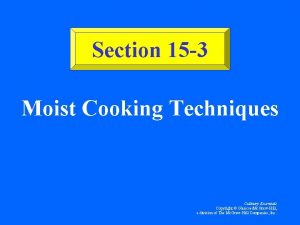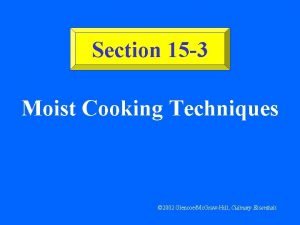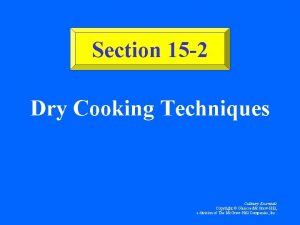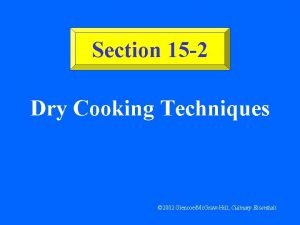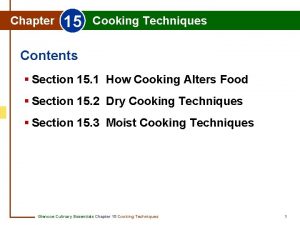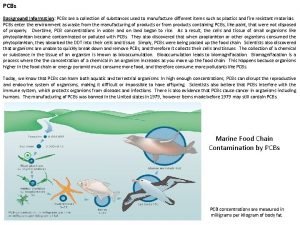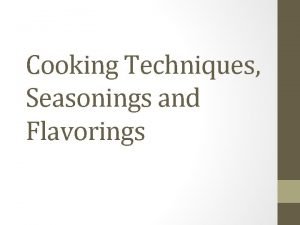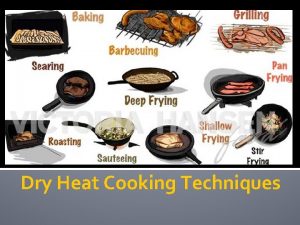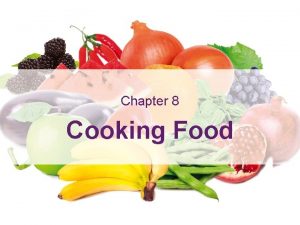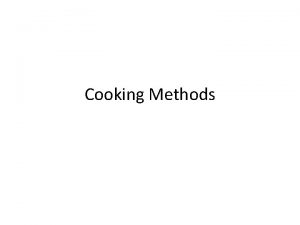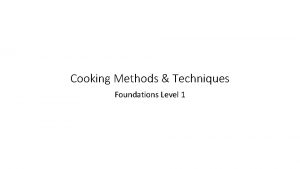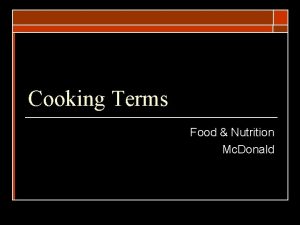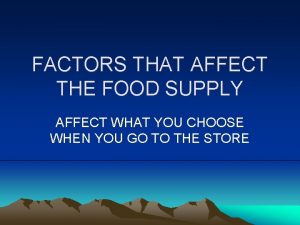Cooking Techniques AND HOW THE AFFECT FOOD Cooking












- Slides: 12

Cooking Techniques AND HOW THE AFFECT FOOD

Cooking is the transfer of energy from a heat source to food. Cooking affects the following aspects of food: Nutritional value Texture Color Aroma Flavor

Dry VS. Moist Dry- applies heat directly as a flame or Moist- applies heat to food by indirectly by surrounding food with submerging it directly n hot liquid or heated air or fat. steam. Techniques include: -Bake -Grill -Broil -Roast -Saute/Stir Fry -Pan Fry -Deep Fry Techniques include: -Poaching 160*-180*F -Simmering 185*-205*F -Boiling 212*F or higher -Steam 212*F or higher -Blanching and parboiling- done in boiling water Dry cooking concentrates flavors because moisture on the surface evaporates and can create caramelization or browning which produced a richness. Moist heat cooking can help to tenderize less tender foods. Flavor and nutrients can be lost from food when using moist heat.

Combination: Braise and Stew In both combination methods the first step is to brown the food using a dry heat method. The second step is to complete cooking by simmering the food in a liquid. Used for less tender cuts of meat as well as some poultry and vegetables. Braising is used for large pieces of food. Stewing is used for small uniform size pieces that are dredged in flour before being sautéed. Combination cooking methods create a richness in a flavor and also tenderizes meat.

Flavor can be defined as the sensory properties of food these are perceived with: Taste Aroma Temperature Appearance (color and arrangement) Texture

Flavor There are 4 tastes that are universally agreed upon: Sweet Sour Salty Bitter The Chinese recognize hot/spicy as a fifth taste. Indian cuisine tries to balance 6 tastes by including astringent. The taste umami (Japan) is also called savory.

Seasoning Seasoning- ingredients that enhance the flavor of food without changing the natural flavor. Salt is the most basic and most commonly used seasoning. Monosodium Glutamate (MSG)- Comes from seaweed and intensifies the natural flavors of most of the foods it’s added to.

Flavoring Flavoring- an item that adds a new taste to food and/or alters its natural flavors. Herbs The leaves, stems and flowers of aromatic plants. Available fresh and dry. Fresh herbs are usually added at the end of cooking, while dried are added at the beginning. Store dried herbs in airtight containers away from heat and light. Fresh herbs should be loosely wrapped in a damp cloth and refrigerated.

Flavoring Spices Bark, buds, fruit, roots, seeds or berries. Usually used in dry form, available whole or ground. Store in airtight containers and avoid light. Pepper is the most common spice used.

Flavoring Vinegars- Thin, sour, acidic liquid that can be used to add flavor during cooking and/or as a condiment. Vinegar is often named for the ingredient its made from: Wine vinegars are made form wine and contain no alcohol. Cinder= Rice= apples rice Balsamic vinegar is made from grapes, reduced and aged in wooden barrels for 4 -50 years. It has a high acidic level, but a sweetness that helps cover the tartness.

Flavoring Condiments- Sauces that are served as an accompaniment to foods. May be used to alter or enhance flavor. Common condiments include: ketchup, mustard, salsa, soy sauce, fish sauce, barbeque sauce, hot sauce and even pickled foods.

Flavorings Extracts- Concentrated flavors that are used most often in baking. Common extracts include: vanilla, almond and lemon Onions including: scallions, leeks, shallots, chives and garlic. Lemon- Use only the zest or juice. Nuts- add flavor, texture and color.
 Cooking food in a liquid between 150-185
Cooking food in a liquid between 150-185 Section 15-3 moist cooking techniques
Section 15-3 moist cooking techniques Section 15-2 dry cooking techniques
Section 15-2 dry cooking techniques Section 15-2 dry cooking techniques
Section 15-2 dry cooking techniques Cooking methods vocabulary
Cooking methods vocabulary Basic cooking techniques
Basic cooking techniques Is microwaving a dry heat method
Is microwaving a dry heat method Dry heat cooking examples
Dry heat cooking examples Unit 2 food food food
Unit 2 food food food Food chain sequence
Food chain sequence Cooking makes food soft tasty and
Cooking makes food soft tasty and Factors that affect food security
Factors that affect food security How does biomagnification affect a food chain/web?
How does biomagnification affect a food chain/web?
